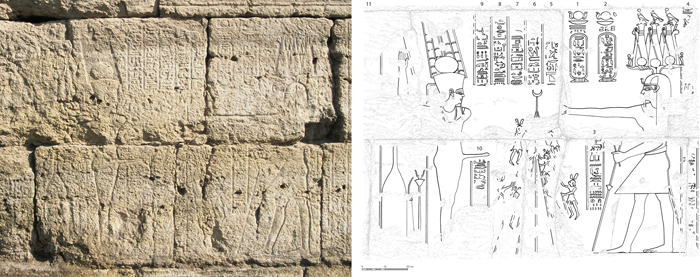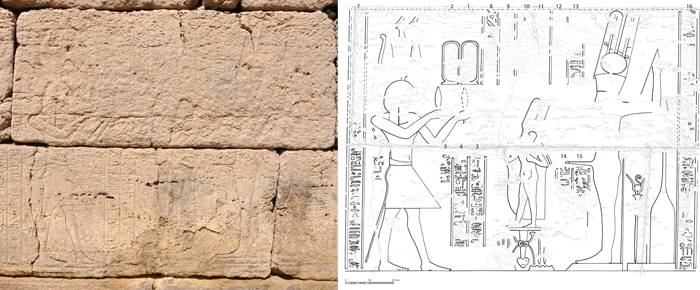Roman Emperor Dressed As Egyptian Pharaoh in Newfound Carving

An ancient stone carving on the walls of an Egyptian temple depicts the Roman emperor Claudius dressed as an Egyptian pharaoh, wearing an elaborate crown, a team of researchers has discovered.
In the carving, Emperor Claudius, who reigned from A.D. 41 to 54, is shown erecting a giant pole with a lunar crescent at the top. Eight men, each wearing two feathers, are shown climbing the supporting poles, with their legs dangling in midair.
Egyptian hieroglyphs in the carving call Claudius the "Son of Ra, Lord of the Crowns," and say he is "King of Upper and Lower Egypt, Lord of the Two Lands." The hieroglyphs say he is raising the pole of the tent (or cult chapel) of Min (an ancient Egyptian god of fertility and power) and notes a date indicating a ritual like this took place around the summertime researchers say. It would have taken place even though Claudius never visited Egypt. A cult chapel is a place of worship and a tent could also be used for this purpose. [See Photos of the Egyptian Carving and Emperor]
The elaborate crown on Claudius consists of three rushes (plants) set on ram horns with three falcons sitting on top. Three solar discs representing the sun (one for each plant) are shown in front of the rushes. Egyptian rulers are shown wearing crowns like this relatively late in ancient Egyptian history, mainly after 332 B.C., and they were worn only in Egypt. The Roman Empire took over Egypt in 30 B.C., and while the Roman emperors were not Egyptian, they were still depicted as pharaohs Egyptologists have noted.
In the recently discovered carving, the god Min is shown wearing his own crown and has an erect penis, because Min was a god of fertility, the researchers said. The hieroglyphs describe Min as "the one who brings into control the warhorses, whose fear is in the Two Lands." Min tells Claudius, "I give you the (southern) foreign lands," which researchers say could be a reference to the deserts surrounding the Nile River, where minerals could be quarried.
The scene was discovered on the western exterior wall of the Temple of Isis at Shanhur, located on the east bank of the Nile River about 12 miles (20 kilometers) north of Luxor. It is an Egyptian temple built and decorated during the Roman occupation under Augustus (who reigned from about 30 B.C. to A.D. 14) through to Trajan (who reigned from A.D. 98 to 117). The pole-raising scene was first found during the 2000-2001 excavation season and was recorded in full during the 2010 epigraphic (recording) season. The temple originally had 36 scenes on each of its eastern and western exterior walls, and this new scene, protected for millennia by a layer of dirt, is one of the best preserved.
The study was published recently in the journal Zeitschrift für ägyptische Sprache und Altertumskunde by Martina Minas-Nerpel, a Reader (the American equivalent of an associate professor) at Swansea University in the United Kingdom, and Marleen De Meyer, a postdoctoral researcher at KU Leuven University in Belgium. Careful line drawings of the scene were done by Troy Sagrillo, a senior lecturer at Swansea University.
Sign up for the Live Science daily newsletter now
Get the world’s most fascinating discoveries delivered straight to your inbox.
Roman pharaohs
Although Cleopatrais often called the "last pharaoh of Egypt," the Egyptian priests depicted the Roman emperors as pharaohs up until the fourth century A.D. The Roman emperors allowed, or even encouraged, these depictions in Egyptian temples in order to keep Egypt — which was an important Roman province — stable. [Cleopatra & Olympias: Top 12 Warrior Moms in History]
"Although we know that Claudius, as most Roman emperors, never visited Egypt, his rule over the land at the Nile and the desert regions was legitimized through cultic means," Minas-Nerpel and De Meyer wrote in the journal article. "By decorating the exterior temple wall with this ritual, Claudius theoretically received Min's characteristics and thus his ability to rule over Egypt."
The researchers noted that similar scenes showing a pole being raised for the god Min date as far back as 4,300 years ago, during the age when pyramids were being built in Egypt. This tradition of creating pole-raising scenes was continued into the period of Roman rule.
Real-life ritual
In addition, the date on the carving indicates that a ritual like this took place in real life, the researchers said, adding that people may have climbed the central pole of the chapel of Min. In fact, a priest may have stood in for the absent Claudius, and a statue could have been used to represent Min, Minas-Nerpel said.
"What we see depicted on the temple scene is the ideal scenario," Minas-Nerpel told Live Science. She added that, even before the Romans took over Egypt in 30 B.C., Egypt's pharaohs were unable to take part in each temple ceremony in person, and stand-ins would have been necessary.
Lettuce scene
Another ritual offering at the Shanhur temple depicted at the axially corresponding scene on the eastern exterior wall shows Claudius giving an offering of lettuce to Min, which symbolizes the continued fertility of Egypt. It is located on the east wall and did not have to be excavated. In this scene, the Egyptian god Horus (shown as a child) is depicted between the two.

"[Take for] you the lettuce in order to unite it with your body (or phallus)," Claudius says to Min in hieroglyphs shown on the depiction. At one point, Claudius says, "One is in fear when seeing your face."
The two scenes highlight fertility and victorious power, both of which were important for legitimizing the rule of an absent Roman emperor who wanted to control Egypt, Minas-Nerpel and De Meyer wrote.
The Shanhur project and team
In 2009, Minas-Nerpel (principal investigator) and Harco Willems, a professor of Egyptology at the KU Leuven in Belgium, were jointly awarded the research grant by the Gerda Henkel-Foundation of Düsseldorf, Germany, to continue research at the temple of Isis at Shanhur in Upper Egypt. The project was also sponsored by the Engineering and Physical Science Research Council in the United Kingdom. The international team also included De Meyer, Peter Dils (of the Universität Leipzig in Germany), René Preys (of the Facultés Universitaires Notre-Dame de la Paix in Namur and KU Leuven), and Sagrillo. In Egypt, the mission was supported by the Supreme Council of Antiquities, theDeutsches Archäologisches Institut, Cairo (DAI) and the Nederlands-Vlaams Instituut in Cairo.
An article on Shanhur temple by De Meyer and Minas-Nerpel can be seen on the UCLA Encyclopedia of Egyptology at http://escholarship.org/uc/item/5hc3t8dh.
Follow us @livescience, Facebook & Google+. Original article on Live Science.

Owen Jarus is a regular contributor to Live Science who writes about archaeology and humans' past. He has also written for The Independent (UK), The Canadian Press (CP) and The Associated Press (AP), among others. Owen has a bachelor of arts degree from the University of Toronto and a journalism degree from Ryerson University.









